Logistics Management and Supply Chain Analysis: MDC Case Study Report
VerifiedAdded on 2022/10/06
|15
|3153
|29
Report
AI Summary
This report analyzes the logistics management of Medical Devices Company (MDC), a European-based manufacturer of sophisticated medical devices. The report identifies key issues, including challenges in inventory turnover, product obsolescence, and stockouts, which are impacting the company's ability to meet customer demands for increased product availability and service solutions. The analysis applies theories of supply chain and logistics management to diagnose the problems and proposes solutions such as utilizing cloud-based software for real-time inventory tracking, optimizing warehouse locations, and streamlining order processing. The report covers inbound and outbound logistics, key functions like network design and procurement, and emphasizes the need for improved communication and a competitive edge. The goal is to help MDC enhance its efficiency, reduce costs, and improve customer satisfaction by optimizing its supply chain processes.
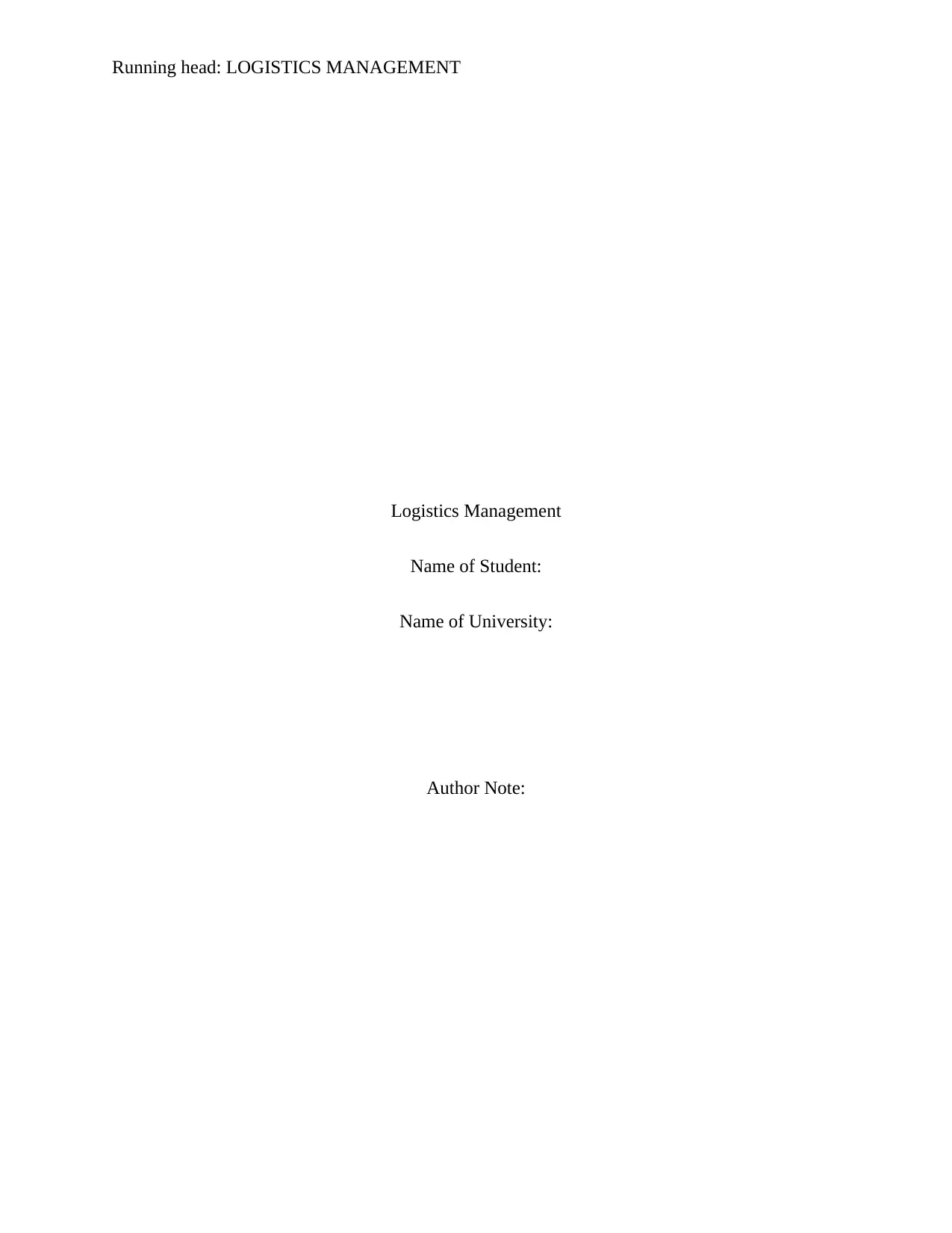
Running head: LOGISTICS MANAGEMENT
Logistics Management
Name of Student:
Name of University:
Author Note:
Logistics Management
Name of Student:
Name of University:
Author Note:
Paraphrase This Document
Need a fresh take? Get an instant paraphrase of this document with our AI Paraphraser
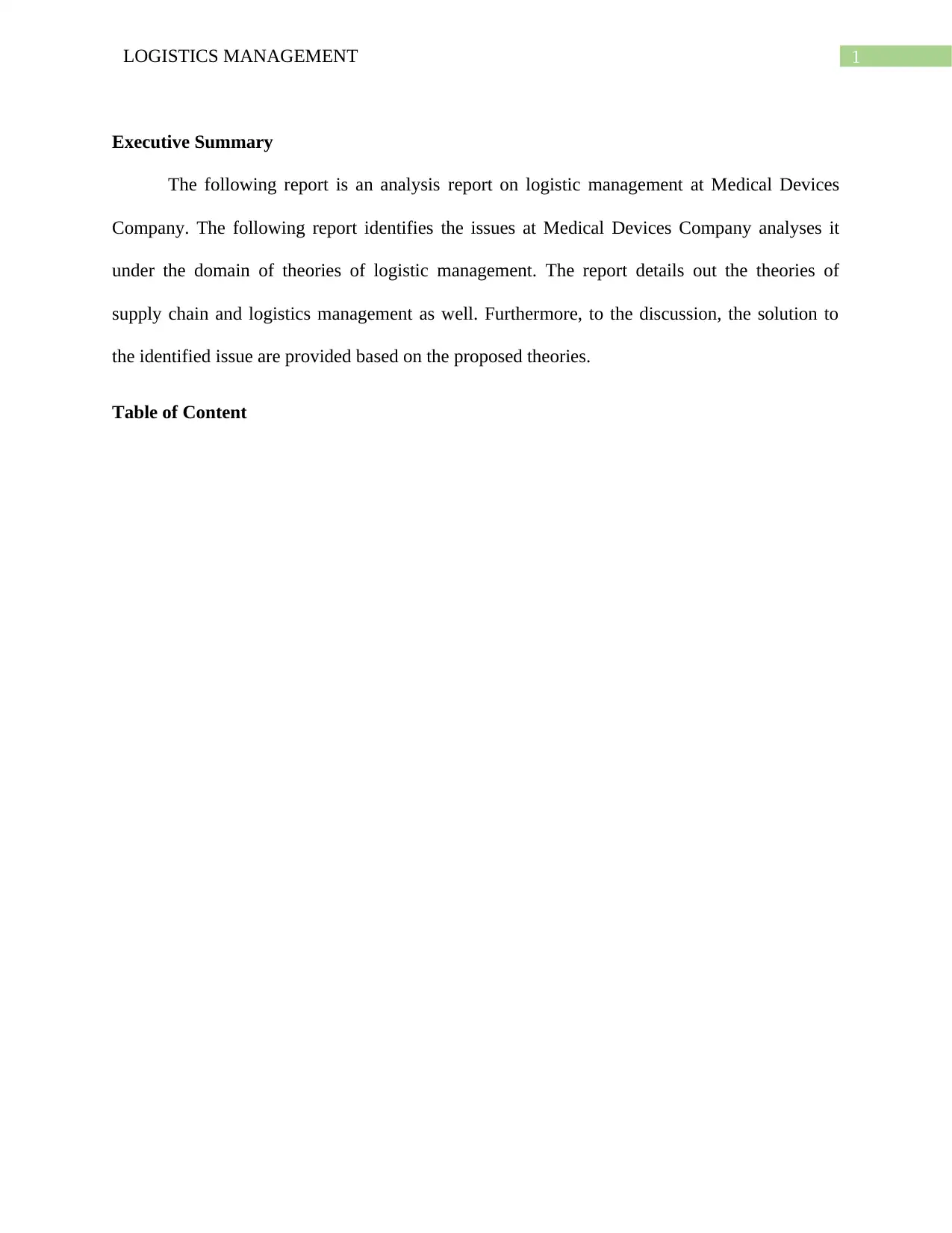
1LOGISTICS MANAGEMENT
Executive Summary
The following report is an analysis report on logistic management at Medical Devices
Company. The following report identifies the issues at Medical Devices Company analyses it
under the domain of theories of logistic management. The report details out the theories of
supply chain and logistics management as well. Furthermore, to the discussion, the solution to
the identified issue are provided based on the proposed theories.
Table of Content
Executive Summary
The following report is an analysis report on logistic management at Medical Devices
Company. The following report identifies the issues at Medical Devices Company analyses it
under the domain of theories of logistic management. The report details out the theories of
supply chain and logistics management as well. Furthermore, to the discussion, the solution to
the identified issue are provided based on the proposed theories.
Table of Content
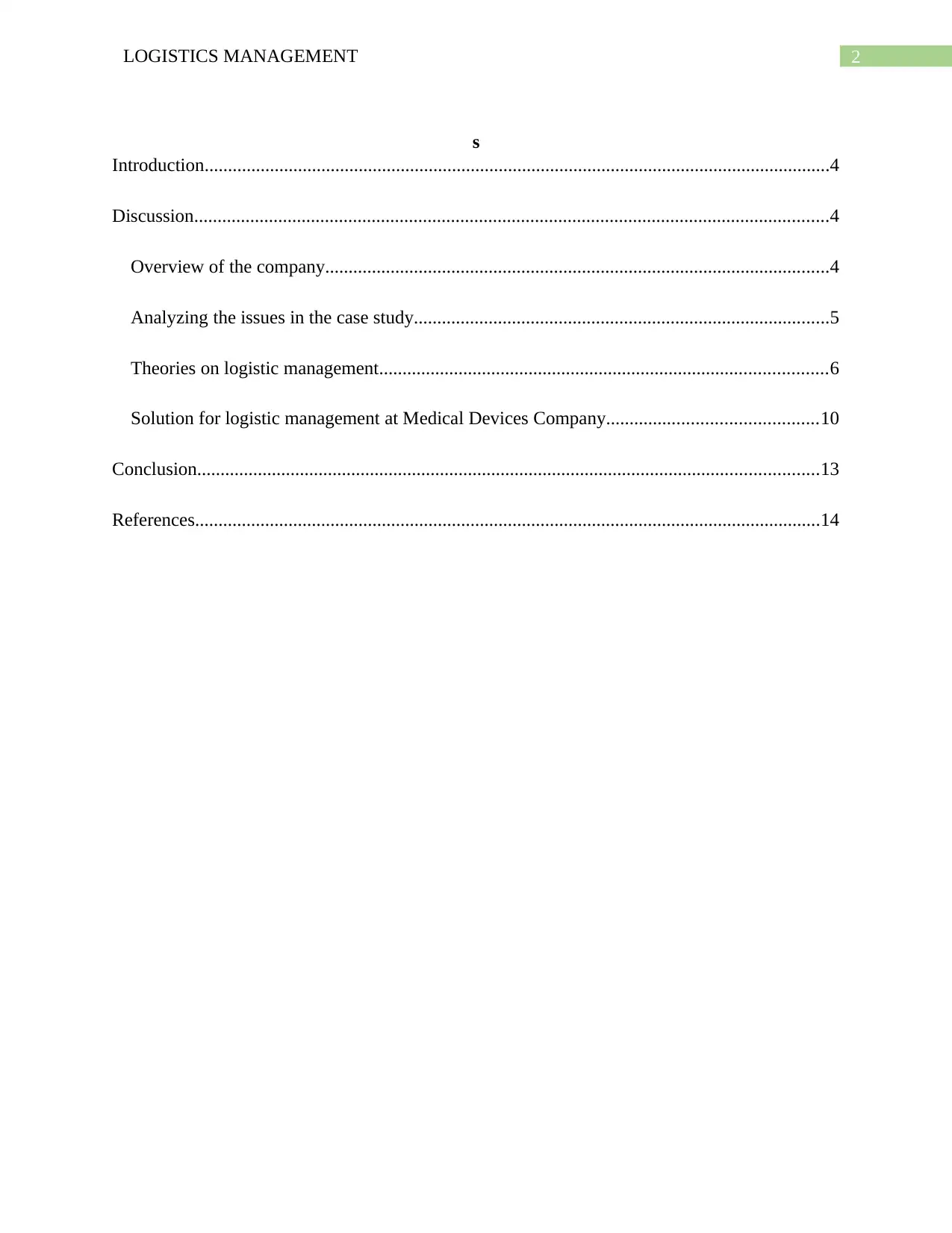
2LOGISTICS MANAGEMENT
s
Introduction......................................................................................................................................4
Discussion........................................................................................................................................4
Overview of the company............................................................................................................4
Analyzing the issues in the case study.........................................................................................5
Theories on logistic management................................................................................................6
Solution for logistic management at Medical Devices Company.............................................10
Conclusion.....................................................................................................................................13
References......................................................................................................................................14
s
Introduction......................................................................................................................................4
Discussion........................................................................................................................................4
Overview of the company............................................................................................................4
Analyzing the issues in the case study.........................................................................................5
Theories on logistic management................................................................................................6
Solution for logistic management at Medical Devices Company.............................................10
Conclusion.....................................................................................................................................13
References......................................................................................................................................14
⊘ This is a preview!⊘
Do you want full access?
Subscribe today to unlock all pages.

Trusted by 1+ million students worldwide
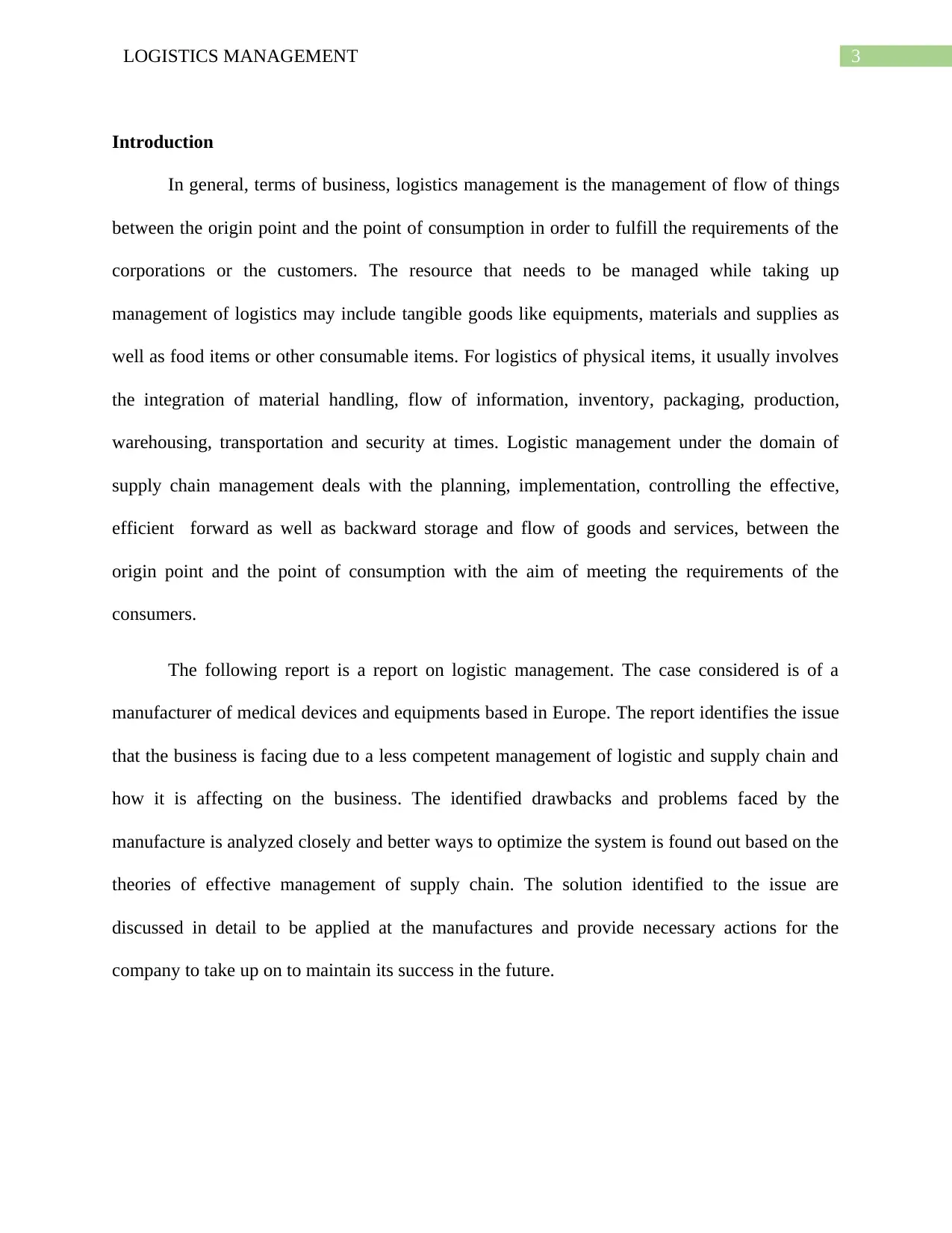
3LOGISTICS MANAGEMENT
Introduction
In general, terms of business, logistics management is the management of flow of things
between the origin point and the point of consumption in order to fulfill the requirements of the
corporations or the customers. The resource that needs to be managed while taking up
management of logistics may include tangible goods like equipments, materials and supplies as
well as food items or other consumable items. For logistics of physical items, it usually involves
the integration of material handling, flow of information, inventory, packaging, production,
warehousing, transportation and security at times. Logistic management under the domain of
supply chain management deals with the planning, implementation, controlling the effective,
efficient forward as well as backward storage and flow of goods and services, between the
origin point and the point of consumption with the aim of meeting the requirements of the
consumers.
The following report is a report on logistic management. The case considered is of a
manufacturer of medical devices and equipments based in Europe. The report identifies the issue
that the business is facing due to a less competent management of logistic and supply chain and
how it is affecting on the business. The identified drawbacks and problems faced by the
manufacture is analyzed closely and better ways to optimize the system is found out based on the
theories of effective management of supply chain. The solution identified to the issue are
discussed in detail to be applied at the manufactures and provide necessary actions for the
company to take up on to maintain its success in the future.
Introduction
In general, terms of business, logistics management is the management of flow of things
between the origin point and the point of consumption in order to fulfill the requirements of the
corporations or the customers. The resource that needs to be managed while taking up
management of logistics may include tangible goods like equipments, materials and supplies as
well as food items or other consumable items. For logistics of physical items, it usually involves
the integration of material handling, flow of information, inventory, packaging, production,
warehousing, transportation and security at times. Logistic management under the domain of
supply chain management deals with the planning, implementation, controlling the effective,
efficient forward as well as backward storage and flow of goods and services, between the
origin point and the point of consumption with the aim of meeting the requirements of the
consumers.
The following report is a report on logistic management. The case considered is of a
manufacturer of medical devices and equipments based in Europe. The report identifies the issue
that the business is facing due to a less competent management of logistic and supply chain and
how it is affecting on the business. The identified drawbacks and problems faced by the
manufacture is analyzed closely and better ways to optimize the system is found out based on the
theories of effective management of supply chain. The solution identified to the issue are
discussed in detail to be applied at the manufactures and provide necessary actions for the
company to take up on to maintain its success in the future.
Paraphrase This Document
Need a fresh take? Get an instant paraphrase of this document with our AI Paraphraser
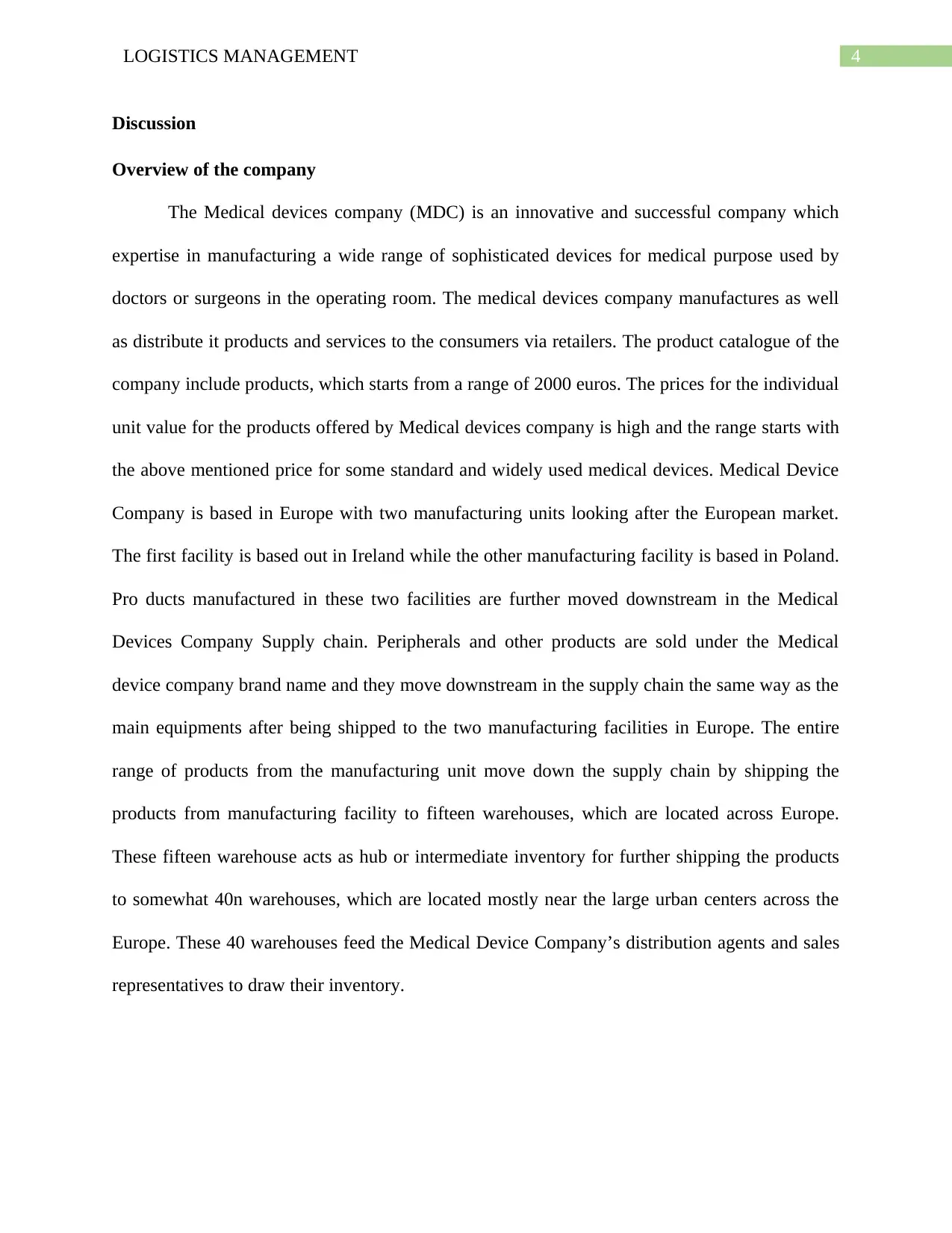
4LOGISTICS MANAGEMENT
Discussion
Overview of the company
The Medical devices company (MDC) is an innovative and successful company which
expertise in manufacturing a wide range of sophisticated devices for medical purpose used by
doctors or surgeons in the operating room. The medical devices company manufactures as well
as distribute it products and services to the consumers via retailers. The product catalogue of the
company include products, which starts from a range of 2000 euros. The prices for the individual
unit value for the products offered by Medical devices company is high and the range starts with
the above mentioned price for some standard and widely used medical devices. Medical Device
Company is based in Europe with two manufacturing units looking after the European market.
The first facility is based out in Ireland while the other manufacturing facility is based in Poland.
Pro ducts manufactured in these two facilities are further moved downstream in the Medical
Devices Company Supply chain. Peripherals and other products are sold under the Medical
device company brand name and they move downstream in the supply chain the same way as the
main equipments after being shipped to the two manufacturing facilities in Europe. The entire
range of products from the manufacturing unit move down the supply chain by shipping the
products from manufacturing facility to fifteen warehouses, which are located across Europe.
These fifteen warehouse acts as hub or intermediate inventory for further shipping the products
to somewhat 40n warehouses, which are located mostly near the large urban centers across the
Europe. These 40 warehouses feed the Medical Device Company’s distribution agents and sales
representatives to draw their inventory.
Discussion
Overview of the company
The Medical devices company (MDC) is an innovative and successful company which
expertise in manufacturing a wide range of sophisticated devices for medical purpose used by
doctors or surgeons in the operating room. The medical devices company manufactures as well
as distribute it products and services to the consumers via retailers. The product catalogue of the
company include products, which starts from a range of 2000 euros. The prices for the individual
unit value for the products offered by Medical devices company is high and the range starts with
the above mentioned price for some standard and widely used medical devices. Medical Device
Company is based in Europe with two manufacturing units looking after the European market.
The first facility is based out in Ireland while the other manufacturing facility is based in Poland.
Pro ducts manufactured in these two facilities are further moved downstream in the Medical
Devices Company Supply chain. Peripherals and other products are sold under the Medical
device company brand name and they move downstream in the supply chain the same way as the
main equipments after being shipped to the two manufacturing facilities in Europe. The entire
range of products from the manufacturing unit move down the supply chain by shipping the
products from manufacturing facility to fifteen warehouses, which are located across Europe.
These fifteen warehouse acts as hub or intermediate inventory for further shipping the products
to somewhat 40n warehouses, which are located mostly near the large urban centers across the
Europe. These 40 warehouses feed the Medical Device Company’s distribution agents and sales
representatives to draw their inventory.
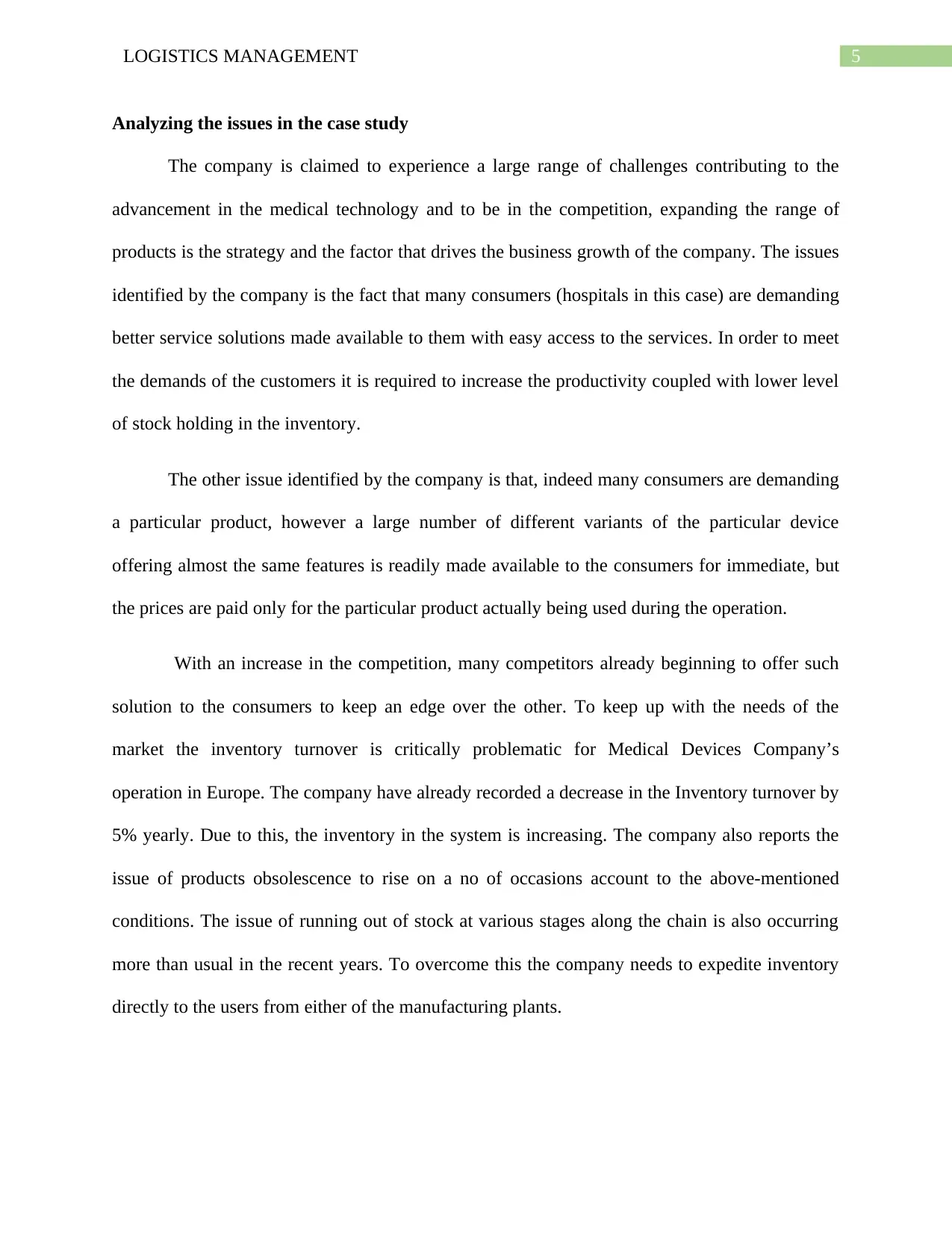
5LOGISTICS MANAGEMENT
Analyzing the issues in the case study
The company is claimed to experience a large range of challenges contributing to the
advancement in the medical technology and to be in the competition, expanding the range of
products is the strategy and the factor that drives the business growth of the company. The issues
identified by the company is the fact that many consumers (hospitals in this case) are demanding
better service solutions made available to them with easy access to the services. In order to meet
the demands of the customers it is required to increase the productivity coupled with lower level
of stock holding in the inventory.
The other issue identified by the company is that, indeed many consumers are demanding
a particular product, however a large number of different variants of the particular device
offering almost the same features is readily made available to the consumers for immediate, but
the prices are paid only for the particular product actually being used during the operation.
With an increase in the competition, many competitors already beginning to offer such
solution to the consumers to keep an edge over the other. To keep up with the needs of the
market the inventory turnover is critically problematic for Medical Devices Company’s
operation in Europe. The company have already recorded a decrease in the Inventory turnover by
5% yearly. Due to this, the inventory in the system is increasing. The company also reports the
issue of products obsolescence to rise on a no of occasions account to the above-mentioned
conditions. The issue of running out of stock at various stages along the chain is also occurring
more than usual in the recent years. To overcome this the company needs to expedite inventory
directly to the users from either of the manufacturing plants.
Analyzing the issues in the case study
The company is claimed to experience a large range of challenges contributing to the
advancement in the medical technology and to be in the competition, expanding the range of
products is the strategy and the factor that drives the business growth of the company. The issues
identified by the company is the fact that many consumers (hospitals in this case) are demanding
better service solutions made available to them with easy access to the services. In order to meet
the demands of the customers it is required to increase the productivity coupled with lower level
of stock holding in the inventory.
The other issue identified by the company is that, indeed many consumers are demanding
a particular product, however a large number of different variants of the particular device
offering almost the same features is readily made available to the consumers for immediate, but
the prices are paid only for the particular product actually being used during the operation.
With an increase in the competition, many competitors already beginning to offer such
solution to the consumers to keep an edge over the other. To keep up with the needs of the
market the inventory turnover is critically problematic for Medical Devices Company’s
operation in Europe. The company have already recorded a decrease in the Inventory turnover by
5% yearly. Due to this, the inventory in the system is increasing. The company also reports the
issue of products obsolescence to rise on a no of occasions account to the above-mentioned
conditions. The issue of running out of stock at various stages along the chain is also occurring
more than usual in the recent years. To overcome this the company needs to expedite inventory
directly to the users from either of the manufacturing plants.
⊘ This is a preview!⊘
Do you want full access?
Subscribe today to unlock all pages.

Trusted by 1+ million students worldwide
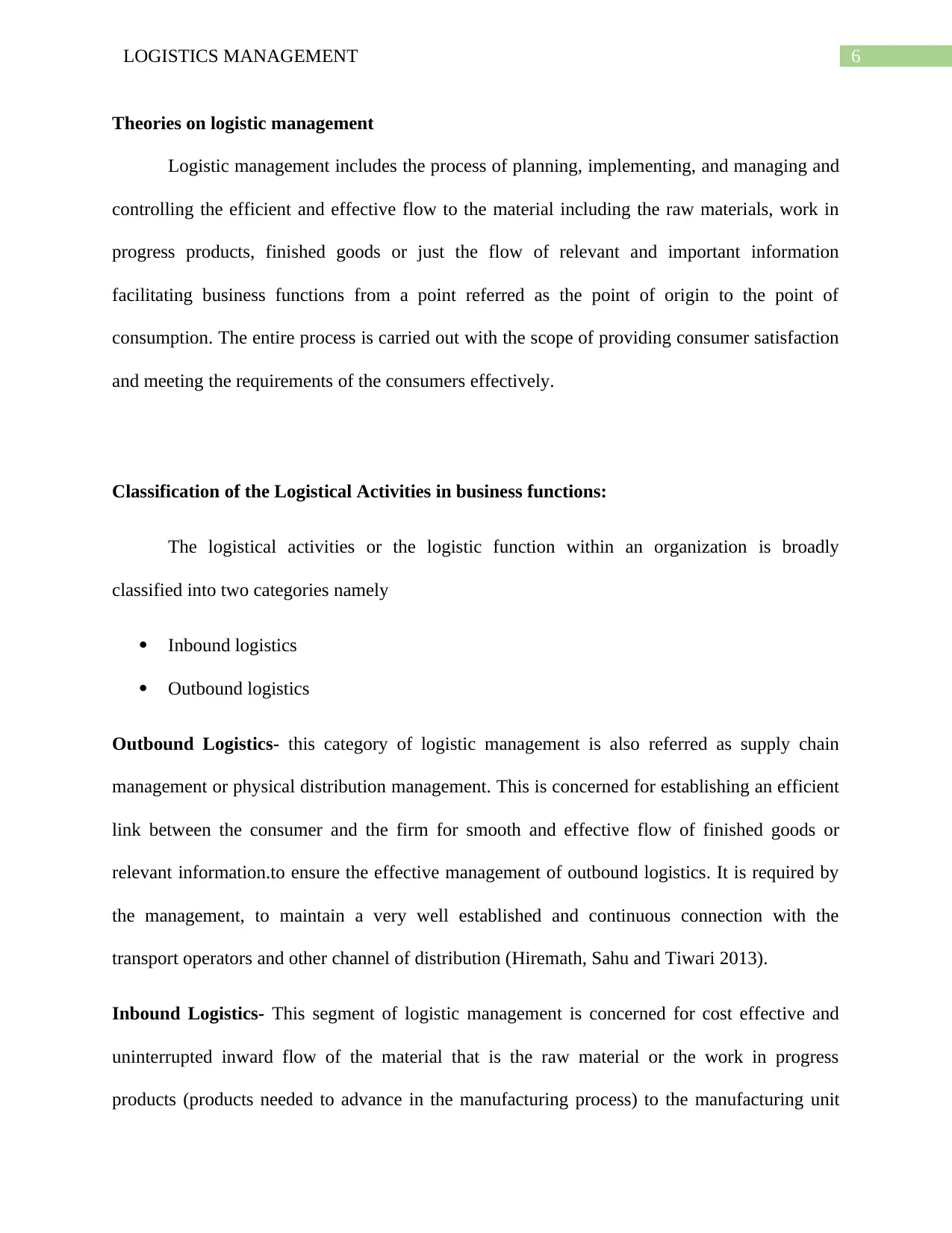
6LOGISTICS MANAGEMENT
Theories on logistic management
Logistic management includes the process of planning, implementing, and managing and
controlling the efficient and effective flow to the material including the raw materials, work in
progress products, finished goods or just the flow of relevant and important information
facilitating business functions from a point referred as the point of origin to the point of
consumption. The entire process is carried out with the scope of providing consumer satisfaction
and meeting the requirements of the consumers effectively.
Classification of the Logistical Activities in business functions:
The logistical activities or the logistic function within an organization is broadly
classified into two categories namely
Inbound logistics
Outbound logistics
Outbound Logistics- this category of logistic management is also referred as supply chain
management or physical distribution management. This is concerned for establishing an efficient
link between the consumer and the firm for smooth and effective flow of finished goods or
relevant information.to ensure the effective management of outbound logistics. It is required by
the management, to maintain a very well established and continuous connection with the
transport operators and other channel of distribution (Hiremath, Sahu and Tiwari 2013).
Inbound Logistics- This segment of logistic management is concerned for cost effective and
uninterrupted inward flow of the material that is the raw material or the work in progress
products (products needed to advance in the manufacturing process) to the manufacturing unit
Theories on logistic management
Logistic management includes the process of planning, implementing, and managing and
controlling the efficient and effective flow to the material including the raw materials, work in
progress products, finished goods or just the flow of relevant and important information
facilitating business functions from a point referred as the point of origin to the point of
consumption. The entire process is carried out with the scope of providing consumer satisfaction
and meeting the requirements of the consumers effectively.
Classification of the Logistical Activities in business functions:
The logistical activities or the logistic function within an organization is broadly
classified into two categories namely
Inbound logistics
Outbound logistics
Outbound Logistics- this category of logistic management is also referred as supply chain
management or physical distribution management. This is concerned for establishing an efficient
link between the consumer and the firm for smooth and effective flow of finished goods or
relevant information.to ensure the effective management of outbound logistics. It is required by
the management, to maintain a very well established and continuous connection with the
transport operators and other channel of distribution (Hiremath, Sahu and Tiwari 2013).
Inbound Logistics- This segment of logistic management is concerned for cost effective and
uninterrupted inward flow of the material that is the raw material or the work in progress
products (products needed to advance in the manufacturing process) to the manufacturing unit
Paraphrase This Document
Need a fresh take? Get an instant paraphrase of this document with our AI Paraphraser
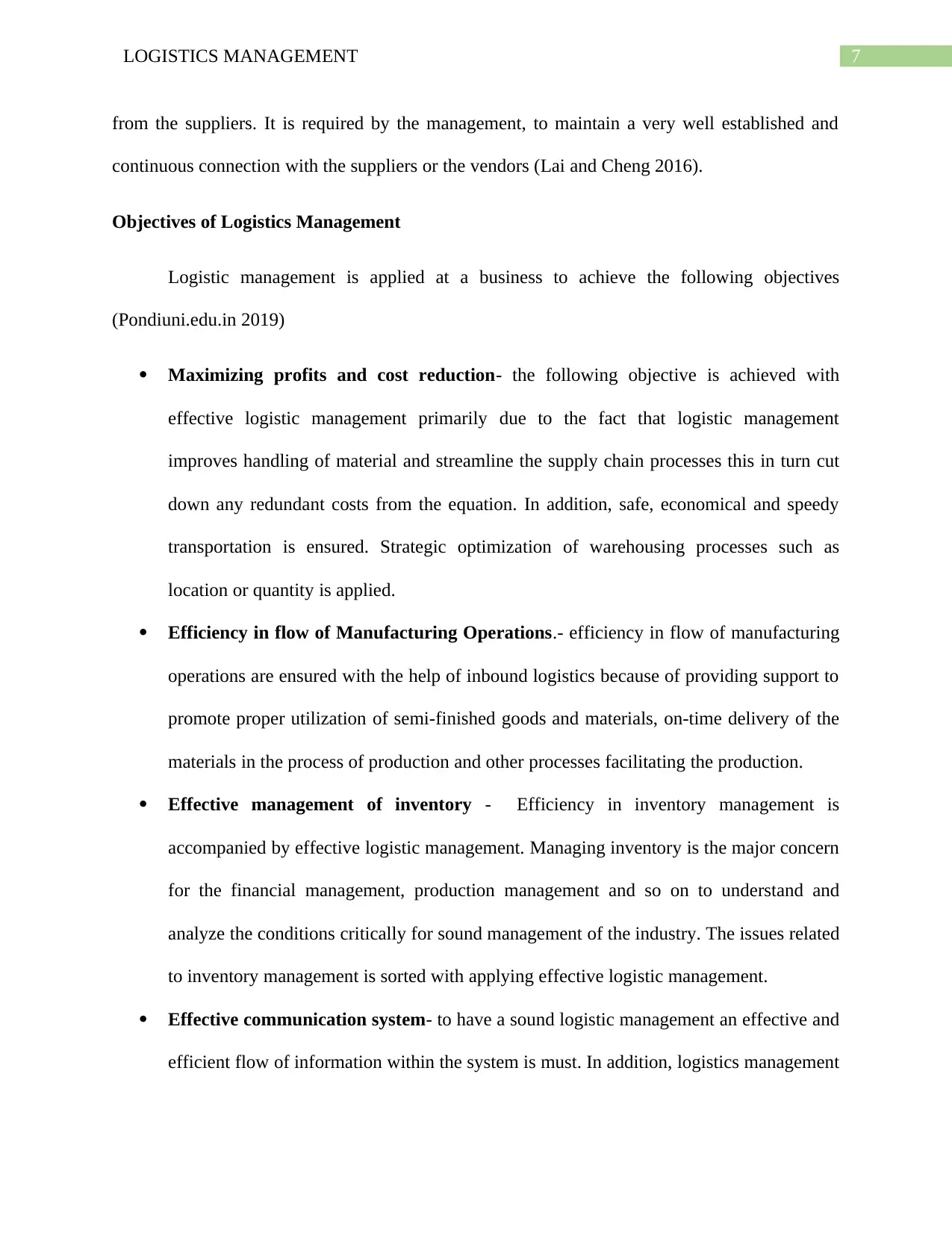
7LOGISTICS MANAGEMENT
from the suppliers. It is required by the management, to maintain a very well established and
continuous connection with the suppliers or the vendors (Lai and Cheng 2016).
Objectives of Logistics Management
Logistic management is applied at a business to achieve the following objectives
(Pondiuni.edu.in 2019)
Maximizing profits and cost reduction- the following objective is achieved with
effective logistic management primarily due to the fact that logistic management
improves handling of material and streamline the supply chain processes this in turn cut
down any redundant costs from the equation. In addition, safe, economical and speedy
transportation is ensured. Strategic optimization of warehousing processes such as
location or quantity is applied.
Efficiency in flow of Manufacturing Operations.- efficiency in flow of manufacturing
operations are ensured with the help of inbound logistics because of providing support to
promote proper utilization of semi-finished goods and materials, on-time delivery of the
materials in the process of production and other processes facilitating the production.
Effective management of inventory - Efficiency in inventory management is
accompanied by effective logistic management. Managing inventory is the major concern
for the financial management, production management and so on to understand and
analyze the conditions critically for sound management of the industry. The issues related
to inventory management is sorted with applying effective logistic management.
Effective communication system- to have a sound logistic management an effective and
efficient flow of information within the system is must. In addition, logistics management
from the suppliers. It is required by the management, to maintain a very well established and
continuous connection with the suppliers or the vendors (Lai and Cheng 2016).
Objectives of Logistics Management
Logistic management is applied at a business to achieve the following objectives
(Pondiuni.edu.in 2019)
Maximizing profits and cost reduction- the following objective is achieved with
effective logistic management primarily due to the fact that logistic management
improves handling of material and streamline the supply chain processes this in turn cut
down any redundant costs from the equation. In addition, safe, economical and speedy
transportation is ensured. Strategic optimization of warehousing processes such as
location or quantity is applied.
Efficiency in flow of Manufacturing Operations.- efficiency in flow of manufacturing
operations are ensured with the help of inbound logistics because of providing support to
promote proper utilization of semi-finished goods and materials, on-time delivery of the
materials in the process of production and other processes facilitating the production.
Effective management of inventory - Efficiency in inventory management is
accompanied by effective logistic management. Managing inventory is the major concern
for the financial management, production management and so on to understand and
analyze the conditions critically for sound management of the industry. The issues related
to inventory management is sorted with applying effective logistic management.
Effective communication system- to have a sound logistic management an effective and
efficient flow of information within the system is must. In addition, logistics management
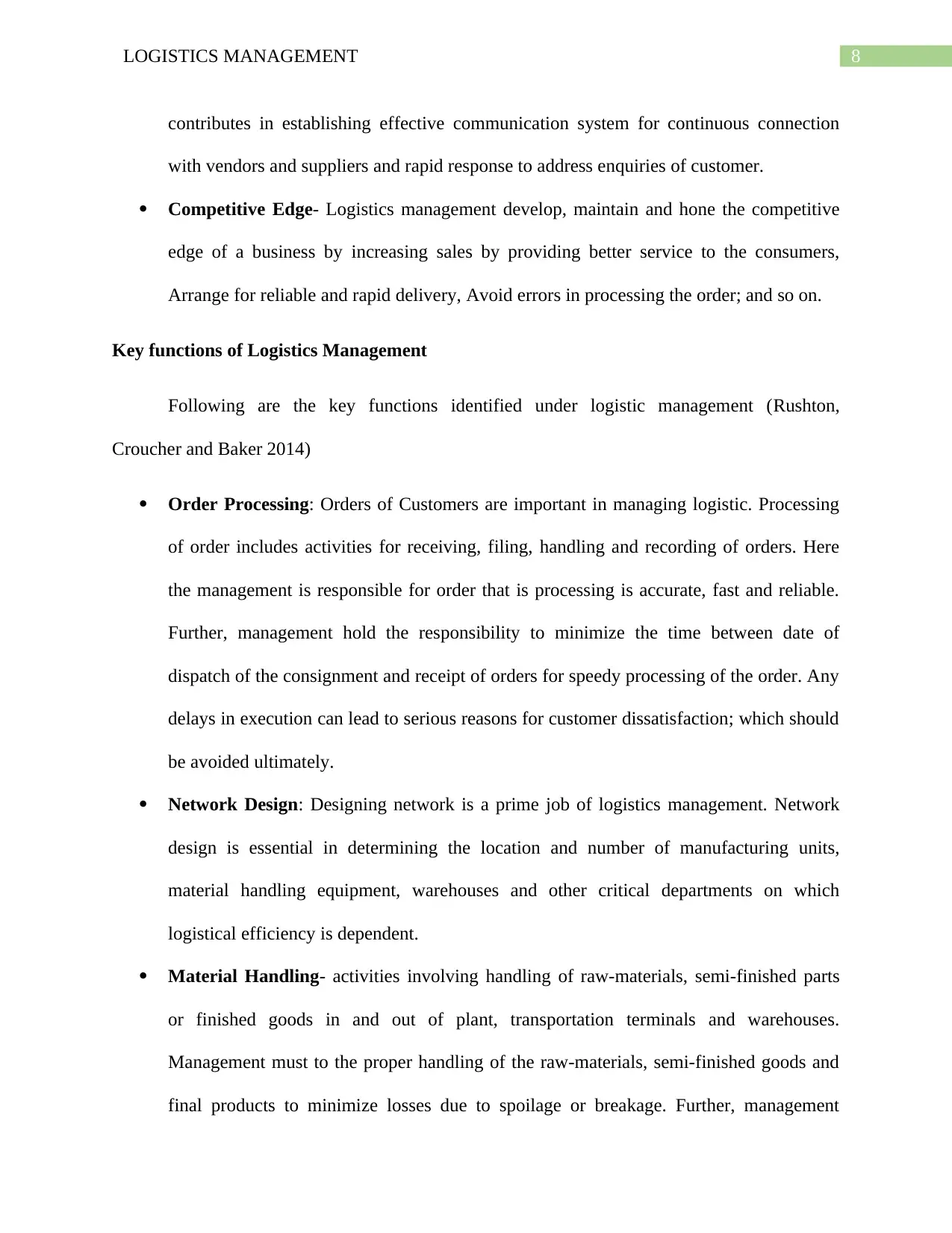
8LOGISTICS MANAGEMENT
contributes in establishing effective communication system for continuous connection
with vendors and suppliers and rapid response to address enquiries of customer.
Competitive Edge- Logistics management develop, maintain and hone the competitive
edge of a business by increasing sales by providing better service to the consumers,
Arrange for reliable and rapid delivery, Avoid errors in processing the order; and so on.
Key functions of Logistics Management
Following are the key functions identified under logistic management (Rushton,
Croucher and Baker 2014)
Order Processing: Orders of Customers are important in managing logistic. Processing
of order includes activities for receiving, filing, handling and recording of orders. Here
the management is responsible for order that is processing is accurate, fast and reliable.
Further, management hold the responsibility to minimize the time between date of
dispatch of the consignment and receipt of orders for speedy processing of the order. Any
delays in execution can lead to serious reasons for customer dissatisfaction; which should
be avoided ultimately.
Network Design: Designing network is a prime job of logistics management. Network
design is essential in determining the location and number of manufacturing units,
material handling equipment, warehouses and other critical departments on which
logistical efficiency is dependent.
Material Handling- activities involving handling of raw-materials, semi-finished parts
or finished goods in and out of plant, transportation terminals and warehouses.
Management must to the proper handling of the raw-materials, semi-finished goods and
final products to minimize losses due to spoilage or breakage. Further, management
contributes in establishing effective communication system for continuous connection
with vendors and suppliers and rapid response to address enquiries of customer.
Competitive Edge- Logistics management develop, maintain and hone the competitive
edge of a business by increasing sales by providing better service to the consumers,
Arrange for reliable and rapid delivery, Avoid errors in processing the order; and so on.
Key functions of Logistics Management
Following are the key functions identified under logistic management (Rushton,
Croucher and Baker 2014)
Order Processing: Orders of Customers are important in managing logistic. Processing
of order includes activities for receiving, filing, handling and recording of orders. Here
the management is responsible for order that is processing is accurate, fast and reliable.
Further, management hold the responsibility to minimize the time between date of
dispatch of the consignment and receipt of orders for speedy processing of the order. Any
delays in execution can lead to serious reasons for customer dissatisfaction; which should
be avoided ultimately.
Network Design: Designing network is a prime job of logistics management. Network
design is essential in determining the location and number of manufacturing units,
material handling equipment, warehouses and other critical departments on which
logistical efficiency is dependent.
Material Handling- activities involving handling of raw-materials, semi-finished parts
or finished goods in and out of plant, transportation terminals and warehouses.
Management must to the proper handling of the raw-materials, semi-finished goods and
final products to minimize losses due to spoilage or breakage. Further, management
⊘ This is a preview!⊘
Do you want full access?
Subscribe today to unlock all pages.

Trusted by 1+ million students worldwide
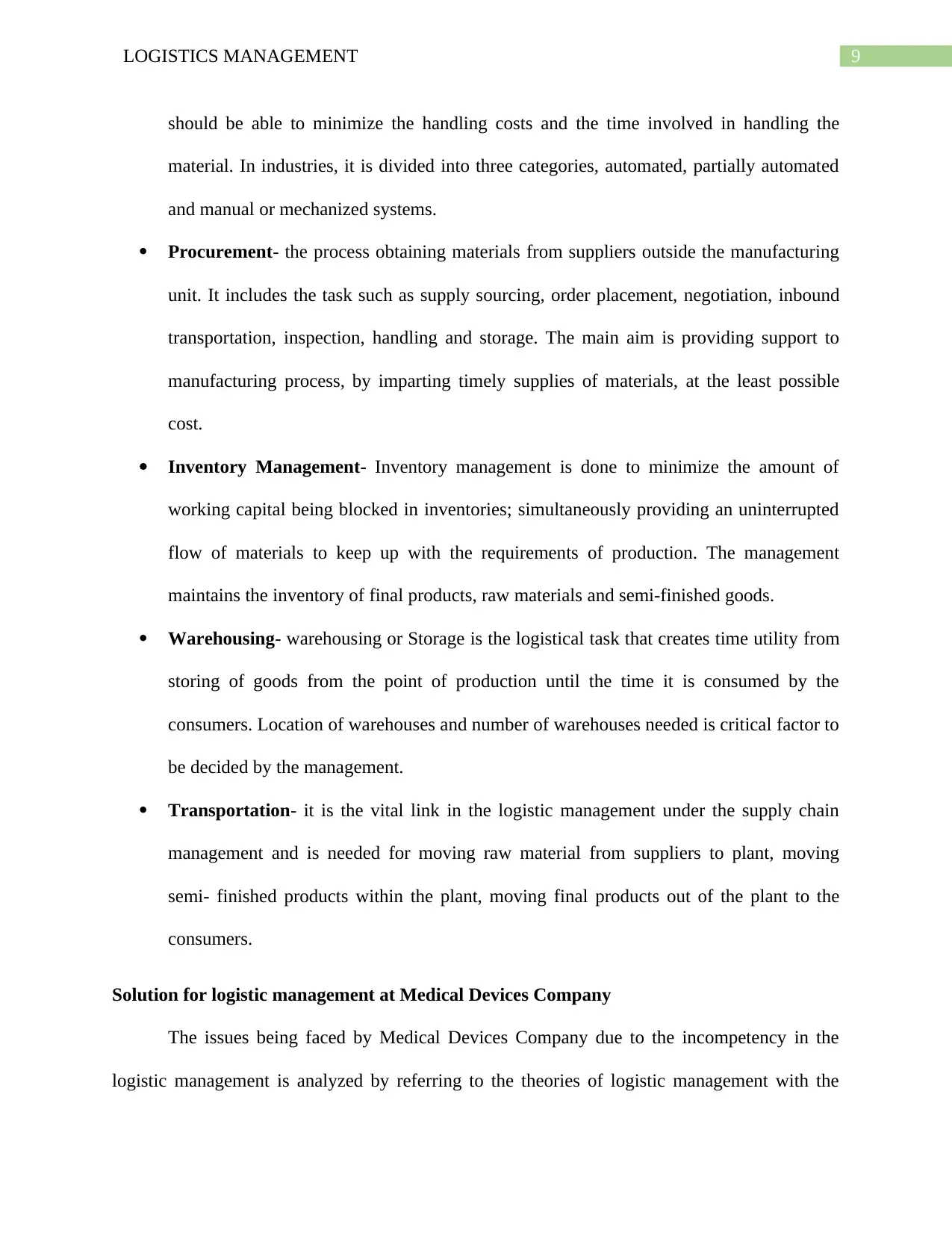
9LOGISTICS MANAGEMENT
should be able to minimize the handling costs and the time involved in handling the
material. In industries, it is divided into three categories, automated, partially automated
and manual or mechanized systems.
Procurement- the process obtaining materials from suppliers outside the manufacturing
unit. It includes the task such as supply sourcing, order placement, negotiation, inbound
transportation, inspection, handling and storage. The main aim is providing support to
manufacturing process, by imparting timely supplies of materials, at the least possible
cost.
Inventory Management- Inventory management is done to minimize the amount of
working capital being blocked in inventories; simultaneously providing an uninterrupted
flow of materials to keep up with the requirements of production. The management
maintains the inventory of final products, raw materials and semi-finished goods.
Warehousing- warehousing or Storage is the logistical task that creates time utility from
storing of goods from the point of production until the time it is consumed by the
consumers. Location of warehouses and number of warehouses needed is critical factor to
be decided by the management.
Transportation- it is the vital link in the logistic management under the supply chain
management and is needed for moving raw material from suppliers to plant, moving
semi- finished products within the plant, moving final products out of the plant to the
consumers.
Solution for logistic management at Medical Devices Company
The issues being faced by Medical Devices Company due to the incompetency in the
logistic management is analyzed by referring to the theories of logistic management with the
should be able to minimize the handling costs and the time involved in handling the
material. In industries, it is divided into three categories, automated, partially automated
and manual or mechanized systems.
Procurement- the process obtaining materials from suppliers outside the manufacturing
unit. It includes the task such as supply sourcing, order placement, negotiation, inbound
transportation, inspection, handling and storage. The main aim is providing support to
manufacturing process, by imparting timely supplies of materials, at the least possible
cost.
Inventory Management- Inventory management is done to minimize the amount of
working capital being blocked in inventories; simultaneously providing an uninterrupted
flow of materials to keep up with the requirements of production. The management
maintains the inventory of final products, raw materials and semi-finished goods.
Warehousing- warehousing or Storage is the logistical task that creates time utility from
storing of goods from the point of production until the time it is consumed by the
consumers. Location of warehouses and number of warehouses needed is critical factor to
be decided by the management.
Transportation- it is the vital link in the logistic management under the supply chain
management and is needed for moving raw material from suppliers to plant, moving
semi- finished products within the plant, moving final products out of the plant to the
consumers.
Solution for logistic management at Medical Devices Company
The issues being faced by Medical Devices Company due to the incompetency in the
logistic management is analyzed by referring to the theories of logistic management with the
Paraphrase This Document
Need a fresh take? Get an instant paraphrase of this document with our AI Paraphraser
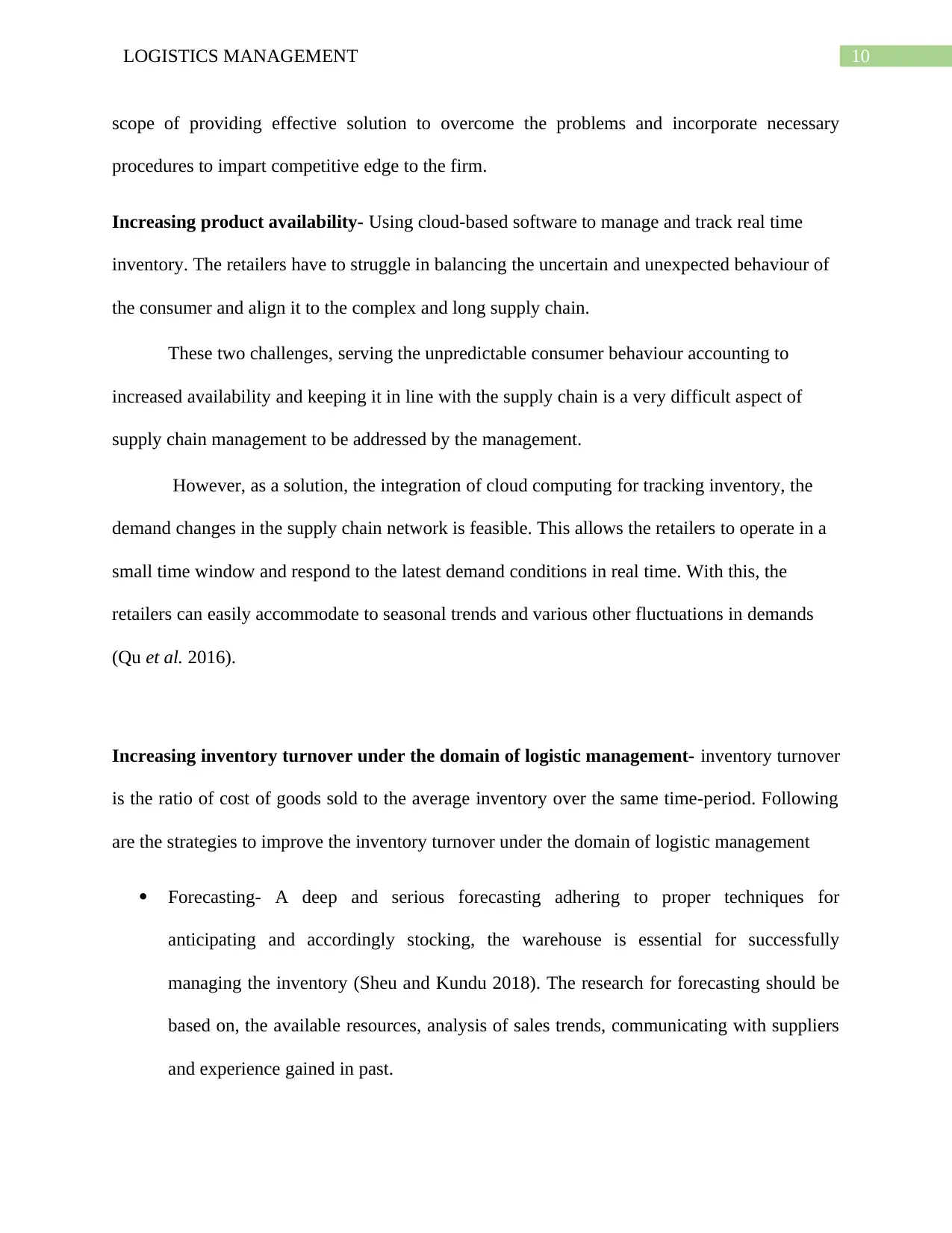
10LOGISTICS MANAGEMENT
scope of providing effective solution to overcome the problems and incorporate necessary
procedures to impart competitive edge to the firm.
Increasing product availability- Using cloud-based software to manage and track real time
inventory. The retailers have to struggle in balancing the uncertain and unexpected behaviour of
the consumer and align it to the complex and long supply chain.
These two challenges, serving the unpredictable consumer behaviour accounting to
increased availability and keeping it in line with the supply chain is a very difficult aspect of
supply chain management to be addressed by the management.
However, as a solution, the integration of cloud computing for tracking inventory, the
demand changes in the supply chain network is feasible. This allows the retailers to operate in a
small time window and respond to the latest demand conditions in real time. With this, the
retailers can easily accommodate to seasonal trends and various other fluctuations in demands
(Qu et al. 2016).
Increasing inventory turnover under the domain of logistic management- inventory turnover
is the ratio of cost of goods sold to the average inventory over the same time-period. Following
are the strategies to improve the inventory turnover under the domain of logistic management
Forecasting- A deep and serious forecasting adhering to proper techniques for
anticipating and accordingly stocking, the warehouse is essential for successfully
managing the inventory (Sheu and Kundu 2018). The research for forecasting should be
based on, the available resources, analysis of sales trends, communicating with suppliers
and experience gained in past.
scope of providing effective solution to overcome the problems and incorporate necessary
procedures to impart competitive edge to the firm.
Increasing product availability- Using cloud-based software to manage and track real time
inventory. The retailers have to struggle in balancing the uncertain and unexpected behaviour of
the consumer and align it to the complex and long supply chain.
These two challenges, serving the unpredictable consumer behaviour accounting to
increased availability and keeping it in line with the supply chain is a very difficult aspect of
supply chain management to be addressed by the management.
However, as a solution, the integration of cloud computing for tracking inventory, the
demand changes in the supply chain network is feasible. This allows the retailers to operate in a
small time window and respond to the latest demand conditions in real time. With this, the
retailers can easily accommodate to seasonal trends and various other fluctuations in demands
(Qu et al. 2016).
Increasing inventory turnover under the domain of logistic management- inventory turnover
is the ratio of cost of goods sold to the average inventory over the same time-period. Following
are the strategies to improve the inventory turnover under the domain of logistic management
Forecasting- A deep and serious forecasting adhering to proper techniques for
anticipating and accordingly stocking, the warehouse is essential for successfully
managing the inventory (Sheu and Kundu 2018). The research for forecasting should be
based on, the available resources, analysis of sales trends, communicating with suppliers
and experience gained in past.
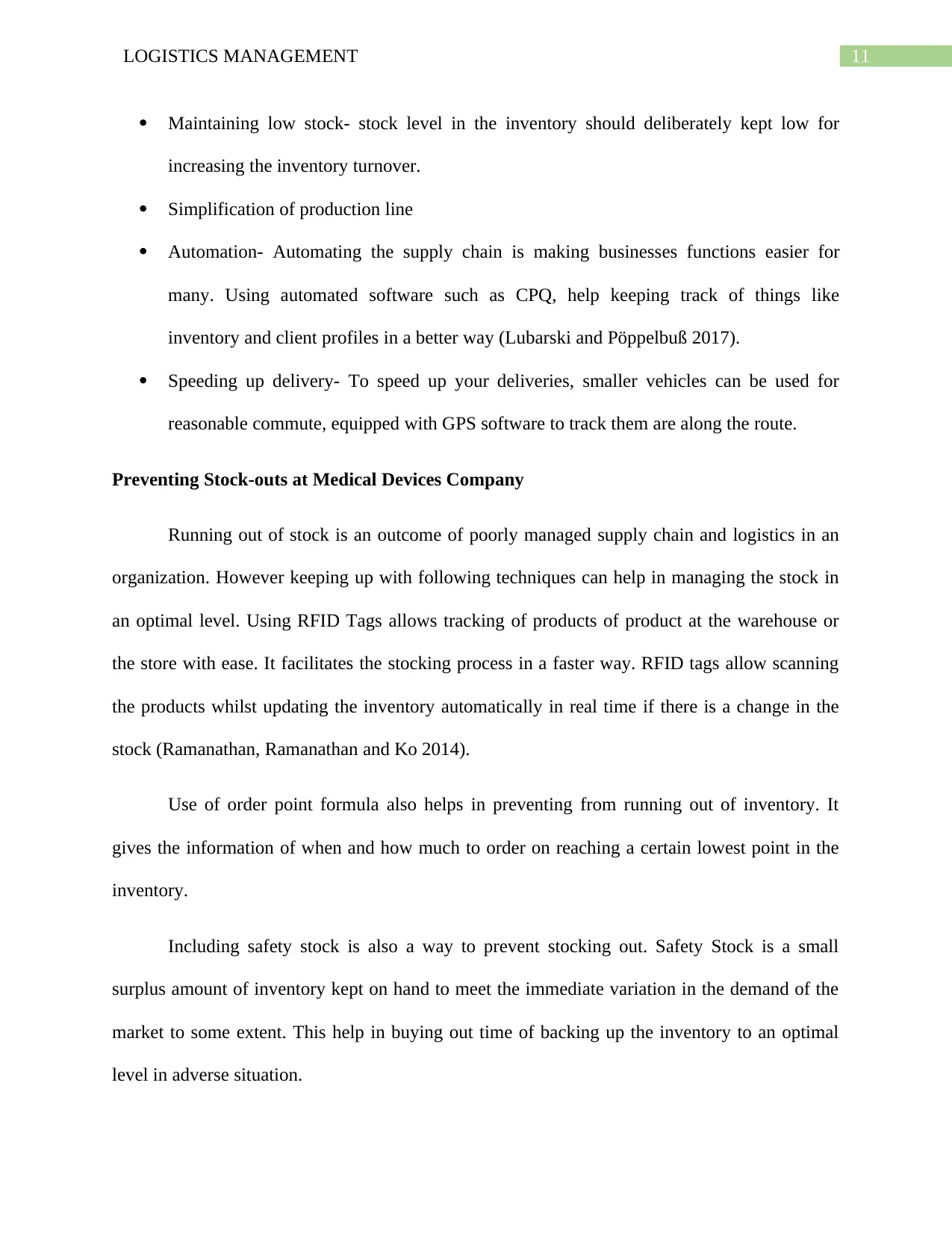
11LOGISTICS MANAGEMENT
Maintaining low stock- stock level in the inventory should deliberately kept low for
increasing the inventory turnover.
Simplification of production line
Automation- Automating the supply chain is making businesses functions easier for
many. Using automated software such as CPQ, help keeping track of things like
inventory and client profiles in a better way (Lubarski and Pöppelbuß 2017).
Speeding up delivery- To speed up your deliveries, smaller vehicles can be used for
reasonable commute, equipped with GPS software to track them are along the route.
Preventing Stock-outs at Medical Devices Company
Running out of stock is an outcome of poorly managed supply chain and logistics in an
organization. However keeping up with following techniques can help in managing the stock in
an optimal level. Using RFID Tags allows tracking of products of product at the warehouse or
the store with ease. It facilitates the stocking process in a faster way. RFID tags allow scanning
the products whilst updating the inventory automatically in real time if there is a change in the
stock (Ramanathan, Ramanathan and Ko 2014).
Use of order point formula also helps in preventing from running out of inventory. It
gives the information of when and how much to order on reaching a certain lowest point in the
inventory.
Including safety stock is also a way to prevent stocking out. Safety Stock is a small
surplus amount of inventory kept on hand to meet the immediate variation in the demand of the
market to some extent. This help in buying out time of backing up the inventory to an optimal
level in adverse situation.
Maintaining low stock- stock level in the inventory should deliberately kept low for
increasing the inventory turnover.
Simplification of production line
Automation- Automating the supply chain is making businesses functions easier for
many. Using automated software such as CPQ, help keeping track of things like
inventory and client profiles in a better way (Lubarski and Pöppelbuß 2017).
Speeding up delivery- To speed up your deliveries, smaller vehicles can be used for
reasonable commute, equipped with GPS software to track them are along the route.
Preventing Stock-outs at Medical Devices Company
Running out of stock is an outcome of poorly managed supply chain and logistics in an
organization. However keeping up with following techniques can help in managing the stock in
an optimal level. Using RFID Tags allows tracking of products of product at the warehouse or
the store with ease. It facilitates the stocking process in a faster way. RFID tags allow scanning
the products whilst updating the inventory automatically in real time if there is a change in the
stock (Ramanathan, Ramanathan and Ko 2014).
Use of order point formula also helps in preventing from running out of inventory. It
gives the information of when and how much to order on reaching a certain lowest point in the
inventory.
Including safety stock is also a way to prevent stocking out. Safety Stock is a small
surplus amount of inventory kept on hand to meet the immediate variation in the demand of the
market to some extent. This help in buying out time of backing up the inventory to an optimal
level in adverse situation.
⊘ This is a preview!⊘
Do you want full access?
Subscribe today to unlock all pages.

Trusted by 1+ million students worldwide
1 out of 15
Related Documents
Your All-in-One AI-Powered Toolkit for Academic Success.
+13062052269
info@desklib.com
Available 24*7 on WhatsApp / Email
![[object Object]](/_next/static/media/star-bottom.7253800d.svg)
Unlock your academic potential
Copyright © 2020–2025 A2Z Services. All Rights Reserved. Developed and managed by ZUCOL.





